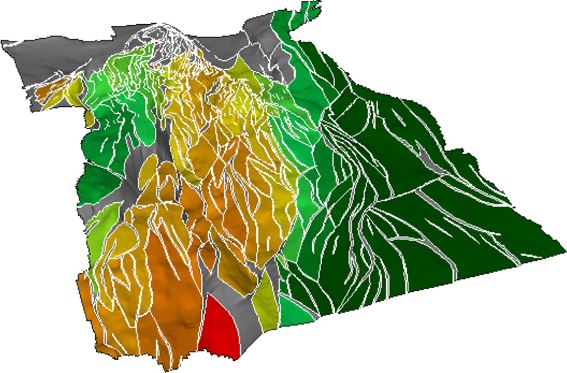Modelling of the fluid pressure distribution over geological periods of time and up to present day can therefore contribute to reduce explorational and technical risks.
Fluid pressure in carrier rocks is generated within pressure cells which are typically bounded by (wholly or partly sealing) faults and low-permeable cap rocks.
Within these cells, pressure can be generated by compaction and chemical diagenesis. It can be dissipated by lateral flow across faults and by vertical leakage through the caprock.
The Pressim module defines the reservoir units into pressure compartments and perform pressure generation within and dissipation between the pressure compartments. The 3D flow pattern on a geological time scale and the resulting pressure distribution are modelled. It is thus possible to achieve a best calibrated case out of a large number of simulations that may form a basis for uncertainty and sensitivity analyses.
Pressim has been successfully applied to numerous case studies on different types of basins. Pressim pressure simulation tools may be integrated to the most common basin modelling tools.
Pressim production
The calibrated flow models from basin modelling studies have shown that the pressure within the reservoir units is a dynamic phenomenon on a geological time scale. If the pressure difference across the lateral barriers is increased (i.e. due to pressure depletion from production) the pressure may even behave dynamically on a production time scale. Pressure communication between adjacent fields in production have been observed all over the world in different types of sedimentary basins.
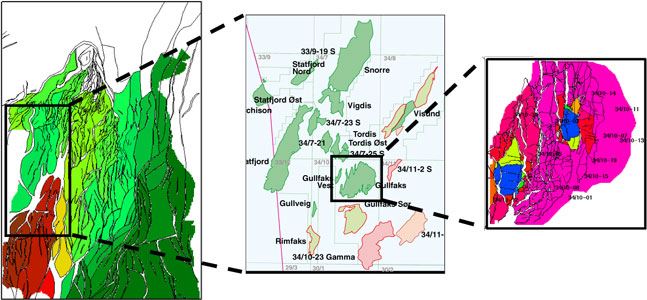
Overpressure modelling at different scales
It is possible to model the pressure communication within a petroleum province using the Pressim tool. The calibrated flow across the boundary can be adopted from a basin modelling pressure study. This technique offers several applications:
- Natural pressure support from surrounding aquifers
- Pressure communication between adjacent fields
- Pressure optimization for petroleum provinces
- Boundary conditions for reservoir simulations
Pressim drilling
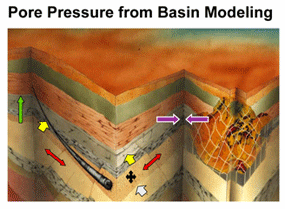
Pressim includes all processes relevant to pressure generation and dissipation. Unique features are related to 3D flow capabilities making it possible to predict the pressure in time and space. Resulting pressure distribution is modelled and a large number of simulations may form a basis for uncertainty and sensitivity analysis.
Output data
- Pressim provides quantitative overpressure information for reservoir units for every modelled pressure compartment and time step
- Output is pressure distribution maps
- Map that shows hydraulic leakage
- Timing and amount of hydraulic leakage
- Pressure profile along well path
- Statistical approach
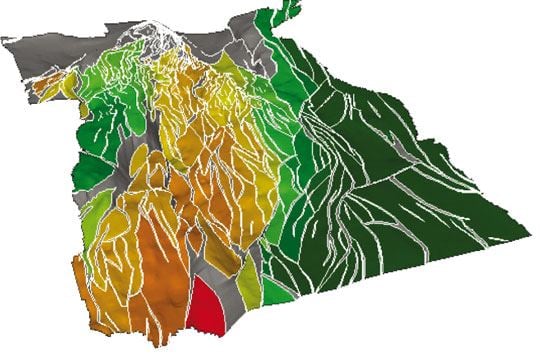
Method
Pressure generation and dissipation are calculated for the pressure compartments of a single-layer reservoir unit. A pressure (and stress) compartment is bounded horizontally by the fault pattern at the top of the reservoir formation, and vertically by the low-permeable rocks.
Pressure generation and dissipation are modelled by quantifying the following geological processes:
| Processes | Comments |
| Lateral flow | The fault transmissibility depends on the burial depth, the length, width and dip-slip displacements of the faults, thickness of the reservoir layers and the permeability inside the fault blocks (Borge & Sylta 1998). |
| Shale drainage | Simplified Darcy fluid flow. |
| Compaction | Model mechanical compaction of shale (Baldwin & Butler 1995), mechanical compaction of sand and chemical compaction of sand (Walderhaug 1996). |
| Hydraulic leakage | Modelling hydraulic fracturing using Griffith and Mohr-Coulomb failure criterion for the first failure, and the sliding failure criterion for reactivation of the fault zone. The minimum horizontal stress is determined using an empirical equation (Grauls 1996). Vertical stress is estimated depending on the overburden. |
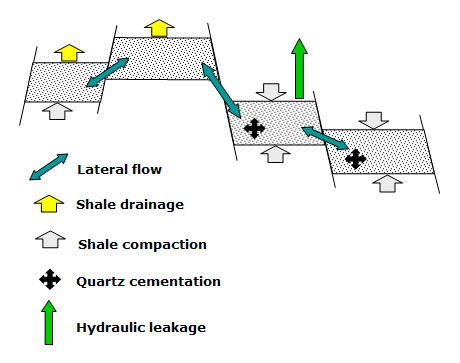
The burial and compaction histories are derived from depth-converted maps of the overlying sediments.
The established model uses fluid mechanical properties of the pore water to estimate the pressure distribution as a function of time.
Lateral fluid flow is modelled using a transmissibility algorithm defined by the dip-slip displacement and burial depths of the faults. Hence, the geo-mechanical properties for the caprock vary through time as a function of subsidence.
The numerical solution employs the “Forward Euler” technique, which is stabilized by using minimum volume during dissipation.
Pressure and stress results are reported for a series of time steps, which are correlated to the depositional ages of the stratigraphic horizons.
References:
Baldwin, B. & Butler, C.O. 1985: Compaction curves. Bulletin of the American Association of Petroleum Geologists 69, 622-626.
Borge, H. & Sylta, Ø. 1998: 3D modelling of fault bounded pressure compartments in the North Viking Graben. Energy, Exploration and Exploitation 16, 301-323.
Grauls, D. 1996: Minimum Principal Stress as a Control of Overpressures in Sedimentary Basins. In: Proceeding of the 8th Conference on Exploration and Production. IFP Report No43313, Institute Français du Pétrole, Rueil-Malmaison.
Walderhaug, O. 1996: Kinetic modelling of quartz cementation and porosity loss in deeply buried sandstone reservoirs. AAPG Bulletin 80(5), 731-745.
Lateral flow
Lateral flow across a fault
Controlling factors for lateral flow are the throw of the fault and the thickness of the carrier.
If the reservoir units overlap (top left), the fault zone leaks, otherwise the fault will be nearly sealing (bottom right).
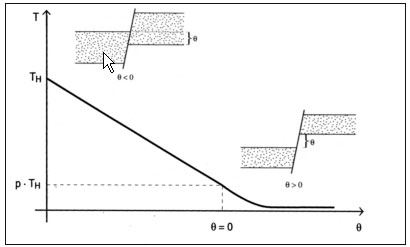
|
Juxtaposition faults show a linear relationship between dip-slip displacement and transmissibilites, while faults with offset have very low transmissibilities.From Borge & Sylta (1998). |
Reference:
Borge, H. & Sylta, Ø. 1998. 3D modelling of fault bounded pressure compartments in the North Viking Graben. Energy, Exploration and Exploitation 16, 301-323.
Hydraulic fracturing and leakage
Criteria for rupturing
The rupture of the cap rock and subsequent is defined as the point when the Mohr circle crosses the Griffith-Coulomb failure envelope. From this point on, the simulator shifts to the frictional sliding criterion, this implies loss of cohesion in the cap rock casing a vertical fluid leakage from the pressure compartment. The empirical model for minimum horizontal stress presented by Grauls (1996), modelled overpressure and the geomechanical properties are used to model Mohr-Coulomb circle.
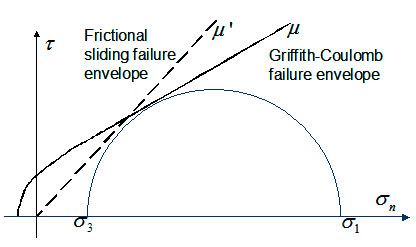
|
A combination of the Griffith-Coulomb failure criterion and the frictional sliding criterion is used in PRESSIM to calculate hydraulic fracture and leakage from top point in overpressured pressure compartments. |
Reference:
Grauls, D. 1996. Minimum Principal Stress as a Control of Overpressures in Sedimentary Basins. In: Proceeding of the 8th Conference on Exploration and Production. IFP Report No43313, Institute Français du Pétrole, Rueil-Malmaison.
Straticital proach
The Pressim pressure simulator is deterministic, while the results we aim to construct are sometimes statistical in nature (e.g. statistical distributions). A simple method by which deterministic models can be made to yield statistical results is, of course, to put the deterministic model inside a Monte-Carlo simulation procedure. This requires that one is able to adjust the variables of the deterministic model for each randomly selected input value specified by the Monte-Carlo simulation procedure and to store the results for later processing.
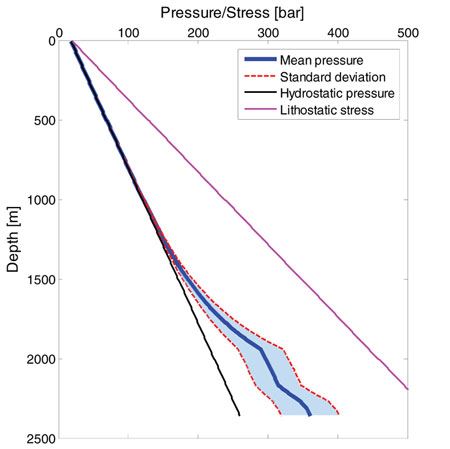
The Pressim MOCA approach starts with an established pressure model for the area. This model contains pressure maps for a series of reservoir units. For each simulation run, important input parameters are selected randomly and usually independently. The more variables one adjusts, the more simulations may have to be run to build reliable probability distributions from the simulation results. There is, in principle, no maximum limit to the number of parameters that can be varied in such a procedure.
For each pressure simulation run, results for all reservoirs (calibration fields and prospects) are stored. After storing the results, the iterative procedure is repeated until enough simulations have been run.
The probability distributions of overpressure can now be built from all the stored simulation results. One important aspect in our set-up is that the simulation results can be weighted according to how well they match the measured overpressures from wells in the area.
Literature
Besides many case studies for our customers resulting in a variety of internal reports, the Pressim software has been used in several scientific projects based on which the following articles and two PhD's were published so far:
Borge, H. 2000: Fault controlled pressure modelling in sedimentary basins. Dr. ing. thesis, Norwegian University of Science and Technology, Trondheim, 156 p.
Borge, H. 2002: Modelling generation and dissipation of overpressure in sedimentary basins: an example from the Halten Terrace, offshore Norway. Marine and Petroleum Geology 19, 377-388.
Borge, H. & Sylta, Ø. 1998. 3D modelling of fault bounded pressure compartments in the North Viking Graben. Energy, Exploration and Exploitation 16, 301-323.
Lothe, A. E. 2004: Simulations of hydraulic fracturing and leakage in sedimentary basins. Dr. Scient. thesis, University of Bergen, Norway, 184 p.
Lothe, A. E., Borge, H. & Gabrielsen, R. H. 2004: Modelling of hydraulic leakage by pressure and stress simulations: An example from the Halten Terrace area, offshore Mid-Norway. Petroleum Geoscience, 10, 199-213.
Lothe, A. E., Borge, H. & Sylta, Ø. 2005: Evaluation of late caprock failure and hydrocarbon entrapment using a linked pressure and stress simulator. Boult, P. & Kaldi, J. (eds). Evaluating fault and cap rock seals: AAPG Hedberg Series, 2, 163-178.
Lothe, A. E., Sylta, Ø., Lauvrak, O. & Sperrevik, S. 2006: Influence of fault resolution on pore pressure distribution and secondary hydrocarbon migration: Tune area, North Sea. Geofluids, 6, 122-136.
Additionally, many results of studies with the Pressim software have been presented at international conferences:
Lothe, A.E. & Tømmerås, A. 2006: Stochastic Monte-Carlo simulations of overpressure probability distribution in the Halten Terrace area, talk on AAPG Conference, Perth, November, 2006. Extended abstract.
Lothe, A.E. 2005: Quantification of uncertainties in pressure simulation. NGU Recent Advances in Petroleum Assessment. Implication for value creation. Trondheim, Norway.
Lothe, A.E., Sylta, Ø., Lauvrak, O. & Sperrevik, S. 2005: Effects of low- and high-resolution fault Interpretations on simulated pressure distributions: An example from the North Sea, AAPG International Conference and Exhibition, Paris, France.
Stoddart, D., Lauvrak, O., Badics, B, Steen, A., Sperrevik, S., Erdmann, M., Vaage, M., Sylta, Ø. & Lothe, A.E. 2005: Calibrated fluid flow and charge modeling using geological and geochemical integrated approach. AAPG Annual Convention, Calgary, Alberta, Canada.
Lothe, A.E., Borge, H. & Gabrielsen, R.H. 2004: Effect of different empirical and theoretical formulas of the minimum horizontal stress in a basin simulator, and the possible impact on pressure build up and hydraulic leakage - example from the Halten Terrace, offshore Mid-Norway. AAPG European Region Conference with GSA, Regional Geology and Hydrocarbon Systems of European & Russian Basins: Looking for Sweet Spots, Praha, Czech.
Lothe, A.E., Sylta, Ø., Lauvrak, O. & Sperrevik, S. 2004: Influence of pore pressure on secondary hydrocarbon migration, Tune area, Viking Graben. GeoMod 2004 International Conference From Mountain to Sedimentary Basins: Modelling and Testing Geological Processes, Emmetten –Lace Lucerne, Switzerland. Bollettinao di Geofiscia, 45.
Lothe, A.E., Borge, H. & Gabrielsen, R.H. 2003: Sub-seismic faults and their possible influence on overpressure and hydraulic leakage - examples from offshore Mid-Norway. EAGE Top and Fault Conference, Montpellier, France.
Borge, H. & Lothe, A.E. 2003: Modelling horizontal stress and hydraulic fracturing in caprocks. EAGE, Stavanger, Norway.
Lothe, A.E., Borge, H. & Sylta, Ø. 2002: Evaluation of late caprock failure on hydrocarbon migration using a linked pressure and stress simulator. AAPG Hedberg Research Conference: Evaluating the Hydrocarbon Sealing Potential of Faults and Caprocks. Barossa Valley, Australia.
Lothe, A. E., Gabrielsen, R. H., Borge, H., Zwarch, C. 2002: Simulation of natural hydraulic leakage due to overpressure: a case study from the Halten Terrace. Nordic Geological Winter Meeting, Island.
Lothe, A. E., Borge, H., Gabrielsen, R. H., Zwach, C. 2001: Coupled pressure and stress simulations through time: a case study from the Halten Terrace area, Mid-Norwegian Margin. Fault Zone Characterization for Tectonic Numerical Modelling Workshop, Frankfurt, Germany.
Do not hesitate to contact us for reprints or additional information on the software and our consultancy work.
Input data
The SEMI GeoBase is automatically used to build the geomodel used in Pressim. The input data needed for a Pressim study is:
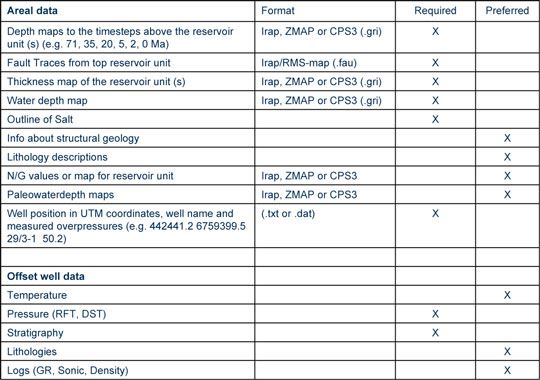
Consultancy
Case studies
SINTEF has a record of more than 10 years in performing basin modelling case studies for exploration divisions of oil companies. Our services include (but not limited to):
- Overpressure modelling
- Pre-drilling pressure predictions
Case studies can usually be started on a short notice (1-2 weeks notice), and may range from simple pressure models (typically 3-4 days), to advanced integrated studies lasting several months.
Case studies
During the last years PRESSIM case studies have been run for many different oil and energy companies including: Statoil, Norsk Hydro, Amoco, BG, BP, Deminex, Enterprise, RWE-DEA, TotalFinaElf, Shell, Chevron, Melrose, Pertra (Det Norske).
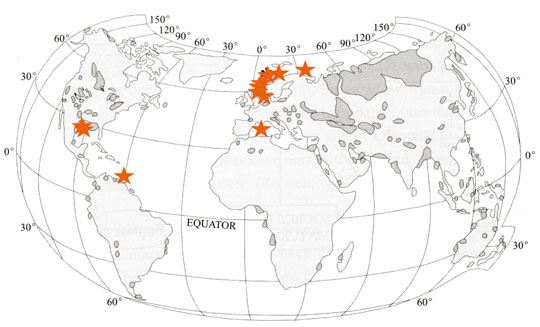
Stars show Pressim studies and grey zones overpressure areas.
Thereby, we gathered experience from many different area of the world:
North Sea (Southern and nothern Viking Graben)The Halten Terrace, offshore NorwayBarents SeaNordland area, offshore NorwayOffshore VenezuelaRhone Delta, offshore FranceFarsund, south of NorwayGulf of Mexico.
Aim and background
The fluid pressure distribution in a carrier or reservoir rock can influence the secondary migration of petroleum in a sedimentary basin. Good estimates of present fluid pressure in yet undrilled prospects are highly relevant for planning safe well layouts and drilling procedures.
The fluid pressure distribution in a carrier or reservoir rock can influence the secondary migration of petroleum in a sedimentary basin. Good estimates of present fluid pressure in yet undrilled prospects are highly relevant for planning safe well layouts and drilling procedures. Modelling of the fluid pressure distribution over geological periods of time and up to Recent can therefore contribute to reduce explorational and technical risks. Fluid pressure in carrier rocks is generated within pressure cells which are typically bounded by (wholly or partly sealing) faults and low-permeable cap rocks. Within these cells, pressure can be generated by compaction and chemical diagenesis. It can be dissipated by lateral flow across faults and by vertical leakage through the caprock. Work on pressure modelling at SINTEF Petroleum Research was initiated by Øyvind Sylta who developed a concept for calculation of transmissibilities across faults. The development of the PRESSIM software started in 1996, as a part of the research project Secondary Migration in Faults and Fractures (SMIFF).
